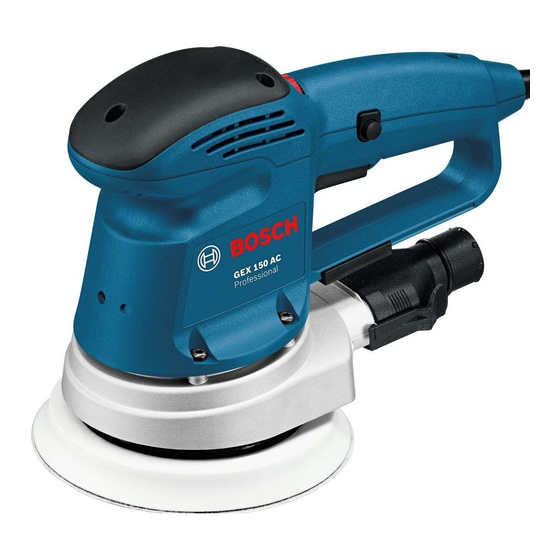Bosch 125 A Manuel d'instructions original - Page 7
Parcourez en ligne ou téléchargez le pdf Manuel d'instructions original pour {nom_de_la_catégorie} Bosch 125 A. Bosch 125 A 11 pages. Gex professional
Également pour Bosch 125 A : Manuel d'instructions original (13 pages)

OBJ_BUCH-424-004.book Page 15 Tuesday, March 15, 2011 3:24 PM
Selecting the Sanding Sheet
Depending on the material to be worked and the required rate of material removal, different sanding sheets are available:
Material
– Paint
– Varnish
– Filling compound
– Filler
Expert for Wood
– All wooden materials (e.g.,
hardwood, softwood, chip-
board, building board)
Best for Wood
– Hardwood
– Particle Board
– Building board
– Metal materials
– Automotive paint
– Masonry, stone
– Marble
– Granite
– Ceramic
– Glass
– Plexiglas
– Glass-fibre plastics
Selection of the Sanding Plate
Depending on the application, the machine can be equipped
with sanding plates of different hardness:
– Soft sanding plate: Suitable for polishing and sensitive
sanding (also for curved surfaces).
– Medium sanding plate: Suitable for all sanding applications
and general-purpose use.
– Hard sanding plate: Suitable for high sanding capacity on
flat surfaces.
Replacing the Sanding Plate (see figure B)
Note: Replace a damaged sanding plate 8 immediately.
Pull off the sanding sheet or polishing tool. Completely un-
screw the screw 11 and take off the sanding plate 8. Attach
the new sanding plate 8 and tighten the screw again.
Note: When attaching the sanding plate, pay attention that
the toothing of the drive element engage into the openings of
the sanding plate.
Bosch Power Tools
Application
For sanding off paint
For sanding primer (e.g., for removing brush dashes,
drops of paint and paint run)
For final sanding of primers before coating
For coarse-sanding, e.g. of rough, unplaned beams and
boards
For face sanding and planing small irregularities
For finish and fine sanding of wood
For pre-sanding
For shaping and braking edges
For final sanding and forming
For polish-sanding and rounding off edges
Dust/Chip Extraction
Dusts from materials such as lead-containing coatings,
some wood types, minerals and metal can be harmful to
one's health. Touching or breathing-in the dusts can cause
allergic reactions and/or lead to respiratory infections of
the user or bystanders.
Certain dusts, such as oak or beech dust, are considered
as carcinogenic, especially in connection with wood-treat-
ment additives (chromate, wood preservative). Materials
containing asbestos may only be worked by specialists.
– As far as possible, use a dust extraction system suitable
for the material.
– Provide for good ventilation of the working place.
– It is recommended to wear a P2 filter-class respirator.
Observe the relevant regulations in your country for the
materials to be worked.
Prevent dust accumulation at the workplace. Dusts can
easily ignite.
English | 15
Grain size
coarse
40
60
medium
80
100
120
fine
180
240
320
400
coarse
40
60
medium
80
100
120
fine
180
240
320
400
coarse
80
medium
100
120
fine
180
240
320
400
very fine
600
1200
1 609 929 Y19 | (15.3.11)
